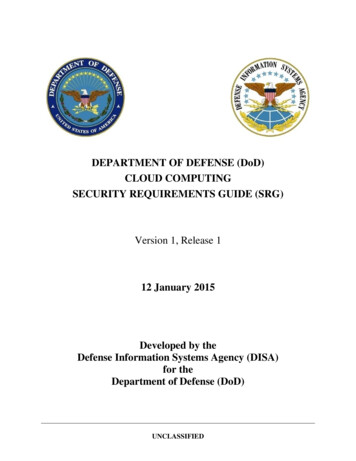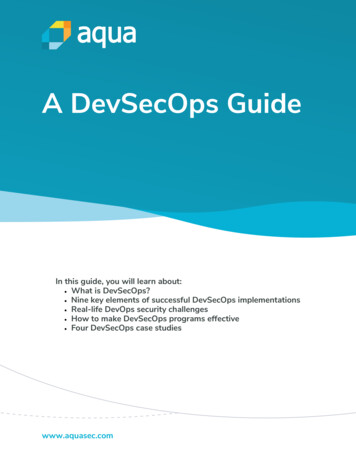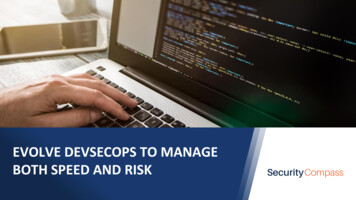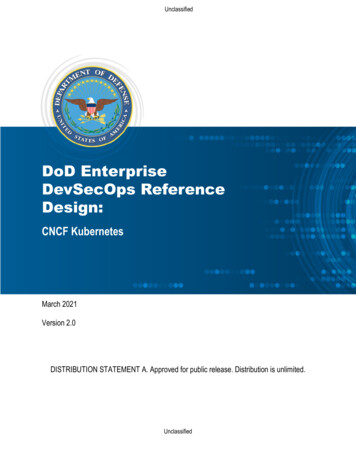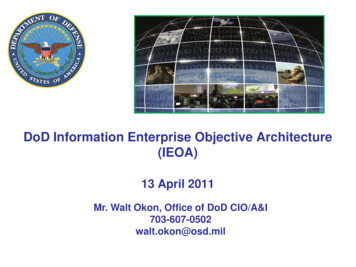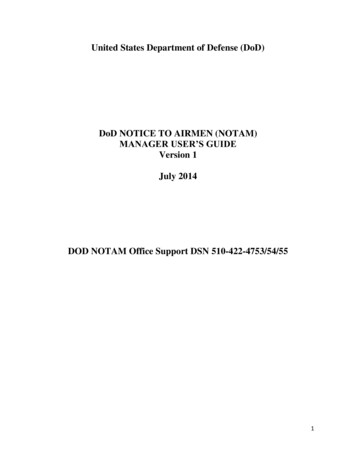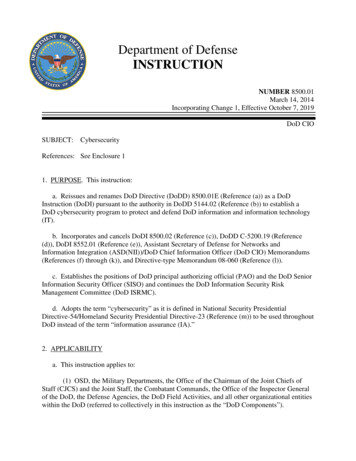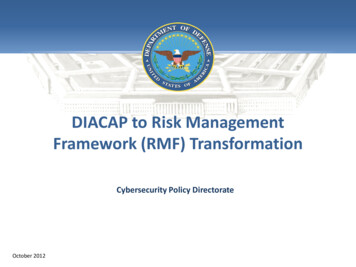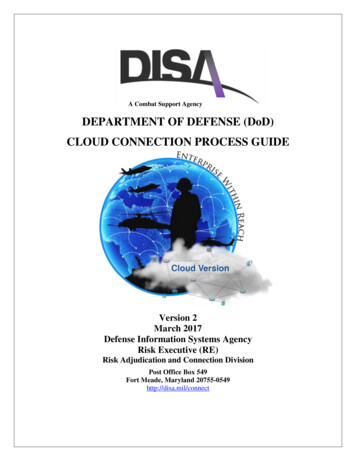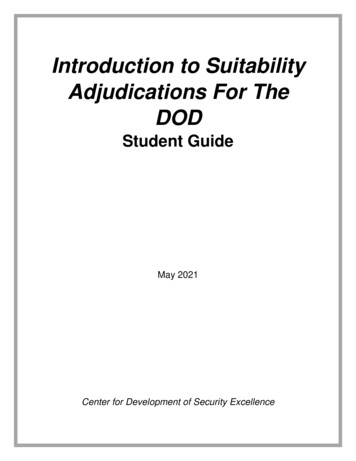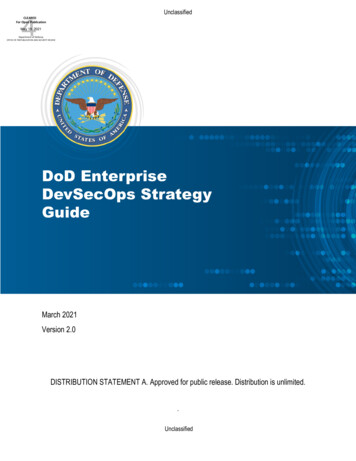
Transcription
UnclassifiedCLEAREDFor Open PublicationUNCLASSIFIEDMay 19, 2021Department of DefenseOFFICE OF PREPUBLICATION AND SECURITY REVIEWDoD EnterpriseDevSecOps StrategyGuideMarch 2021Version 2.0DISTRIBUTION STATEMENT A. Approved for public release. Distribution is unlimited.UnclassifiedUNCLASSIFIED1
UNCLASSIFIEDDocument Set Reference:UNCLASSIFIED2
UNCLASSIFIEDDocument ApprovalsApproved by:JohermanChief nformation Officer of the Department of Defense (Acting)Approved by:Stacy A. CummingsPrincipal Deputy Assistant Secretary of Defense (Acquisition)Performing the Duties of Under Secretary of Defense for Acquisition and Sustainment3Unclassified
UNCLASSIFIEDContentsExecutive Summary . 6Document Set Structure. 7DevSecOps Strategy Guide Document . 9DevSecOps Fundamentals Document . 9DevSecOps Reference Design Document(s) . 9Assumptions . 10DevSecOps Defined . 11Formal Recognition of the Software Supply Chain . 12Construction of Software Factories . 14DevSecOps Guiding Principles . 16Relentless pursuit of Agile . 16Software factories mandate baked-in security . 17Integrated, automated & continuous end-to-end testing and monitoring . 18Immutability of infrastructure achieved via “x as Code” design patterns . 18Adoption of Cloud-smart and data-smart architectural motifs throughout . 18DevSecOps Process Overview . 18DevSecOps Management and Governance . 19Management Structure . 20Recommended Governance . 20Assessment and Authorization . 22Conclusion . 23UNCLASSIFIED4
UNCLASSIFIEDFiguresFigure 1 Pillars to Achieve Resilient Software Capabilities . 6Figure 2 DevSecOps Document Set Overview . 8Figure 3 DevSecOps Distinct Lifecycle Phases and Philosophies . 11Figure 4 Notional Software Supply Chain . 13Figure 5 Normative Software Factory Construct . 15Figure 6 DevSecOps Lifecycle Phases, Continuous Feedback Loops, & Control Gates . 19Figure 7 Notional expansion of a single DevSecOps software factory Pipeline. 21UNCLASSIFIED5
UNCLASSIFIEDExecutive SummaryMany programs and missions across the Department of Defense (DoD) lack softwaredevelopment practices that meet industry standards for agility. The majority of currentcybersecurity frameworks (NIST Cybersecurity Framework, ODNI Cyber Threat Framework,NSA/CSS Technical Cyber Threat Framework v2 (NTCTF), MITRE ATT&CK, etc.) focuspredominately on post-production deployment attack surfaces. Furthermore, every release cycleis perceived as an uphill battle between development teams that attest to functionality,operational test and evaluation teams trying to confirm specific functionality, operations teamsstruggling to install and operate the product, and security teams bolting on protectionmechanisms as an afterthought. To deliver resilient software capability at the speed ofrelevance the department needs to implement strategies that focus on cybersecurity andsurvivability across the development process. The DoD isn’t alone in this journey; industry hasalready minimized deployment friction through a cultural shift to DevSecOps (development,security, and operations).The DoD CIO and the Office of the Under Secretary of Defense for Acquisition and Sustainment(OUSD A&S) recognize the urgent need to rethink our software development practices andculture by leveraging the commercial sector for new approaches and best practices.DevSecOps is such a best practice as it enables the delivery of resilient software capability atthe speed of relevance, a central theme of software modernization across the DoD. DevSecOpsis a proven approach widely adopted by commercial industry and successfully implementedacross multiple DoD pathfinders. DevSecOps is a core tenant of software modernization,technology transformation, and advancing an organization’s software development ecosystemto be more resilient, while ensuring cybersecurity and metrics/feedback are paramount.The DevSecOps software lifecycle approach creates cross-functional teams that unifyhistorically disparate evolutions – development (Dev), cybersecurity (Sec), and operations(Ops). As a unified team they follow Agile principles and embrace a culture that recognizesresilient software is only possible at the intersection of quality, stability, and security, as depictedin Figure 1.Figure 1 Pillars to Achieve Resilient Software CapabilitiesUNCLASSIFIED6
UNCLASSIFIEDThe benefits of adopting DevSecOps include: Reduced mean-time to production: Reduces the average time it takes from when newsoftware features are required until they are running in production;Increased deployment frequency: Increases how often a new release can be deployedinto the production environment;Decreased mean-time to recovery: Decreases the average time it takes to identify andresolve an issue after a production deployment;Decreased change-fail rate: Decreases the probability that a new feature delivered inproduction will result in a failure in operations;Fully automated risk management: Well defined control gates perform riskcharacterization, monitoring, and mitigation as artifacts are released and promotedthrough every step, from ideation through production;Baked-in Cybersecurity: Software updates and patches delivered at the speed ofrelevance.The DoD Enterprise DevSecOps Strategy, along with its supporting document set, provideseducation, best practices, and implementation and operational guidance to InformationTechnology (IT) capability providers, IT capability consumers, application teams, andAuthorizing Officials.Document Set StructureThe momentum and interest in DevSecOps continues to rapidly expand across the DoD and theDefense Industrial Base (DIB). Early adopters of DevSecOps at the DoD have matured toproven practitioners; the resulting wave of fast followers has created a set of practitionersoperating at an intermediate skill set level, and as new programs explore adopting DevSecOps,these novice practitioners are looking for guidance, direction, terminology clarification, and bestpractices. This expanding ecosystem justifies the shift from a single document to a documentset, as depicted below in Figure 2. A document set approach better supports novice,intermediate, and expert practitioners concurrently by enabling them to quickly find the materialthey seek to include: a primer on DevSecOps as a strategy, access to fundamental conceptsand succinct explanations of the DevSecOps lifecycle, and/or specific reference designguidance with deep, technical content.UNCLASSIFIED7
UNCLASSIFIEDFigure 2 DevSecOps Document Set OverviewUNCLASSIFIED8
UNCLASSIFIEDDevSecOps Strategy Guide DocumentThe DevSecOps Strategy Guide (this document) provides an executive summary ofDevSecOps as a whole by establishing a set of strategic guiding principles that every approvedDoD enterprise-wide DevSecOps reference design must support. This document is generallyconsumed by PEOs and anyone in non-technical leadership positions.The strategy guide advocates for a versioned DevSecOps governance process, including amore rigorous and evolving type of Authorization to Operate (ATO) known as ContinuousAuthorization to Operate (cATO). cATO is predicated upon the cyber survivability postureacross the entire software supply chain and is driven by real-time metrics gathered at everystep, compared to the current method which conducts a snapshot in time view once every threeyears to authorize networks. The DIB Software Acquisition and Practices (SWAP) studyemphasized the fact that software is never done. 1 An implied corollary to this statement iscyberspace adversaries never quit. The actions taken to achieve a level of cyber survivabilitytoday may be insufficient tomorrow, justifying the need for DevSecOps Reference Designslinked to a specific version of cATO in order to avoid stale processes that could result inexposure, or worse, compromise.DevSecOps Fundamentals DocumentThe DevSecOps Fundamentals, including associated topic-specific guidebooks andplaybooks, establishes consistent nomenclature, a curated and versioned technology map, andexplores a series of Specific, Measurable, Achievable, Relevant, and Timely (SMART)performance metrics used to manage and monitor a DevSecOps CI/CD pipeline. Guidebooksare intended to provide deep knowledge and industry best practices with respect to a specifictopic area. Playbooks consist of one-page plays, structured to consist of a best practiceintroduction, salient points, and finally a checklist or call-to-action. The Fundamentals document,and its associated guidebooks and playbooks, are generally consumed by DoD enterpriseplatform providers and specific DoD organization DevSecOps teams that manage (instantiateand maintain) a specific DevSecOps software factory implementation.DevSecOps Reference Design Document(s)DevSecOps Reference Design documents define specific tools, technologies, pipelineconstructs, and architectures. A reference design is independently versioned, and must be builtatop of the Fundamentals document. It should also build from and reference the variousguidebooks and playbooks. The intention is to create a composable reference design capacitythat eliminates redundant or inconsistent definitions. Reference designs are then empowered todrive continuous improvement and adopting an industry best practice of an “n – 1” supportlifecycle, ensuring programs continuously modernize and avoid stagnant solutions. TheDevSecOps Reference Design documents are generally consumed by DoD program applicationteams that develop, secure, and operate mission applications.Defense Innovation Board (DIB), “Software Acquisition and Practices (SWAP) Study.” May 03, 2019,[Online]. Available: IED9
UNCLASSIFIEDAssumptionsThis document set makes the following assumptions: For organizations deploying new business solutions or modernizing existing softwaresystems, deploying to an approved or provisionally authorized (PA) cloud environmentwill become their preferred solution technically and culturally. For weapons systems, theenvironment will likely continue to be on premise to facilitate hardware-in-to-loop (HWIL)testing with embedded systems. Rapidly changing technology dictates designing the DevSecOps pipelines and patternsfor flexibility as new development capabilities enter/exit the commercial product market. Cybersecurity elements will leverage cloud service provider (CSP) managed servicecapabilities where practicable. Teams will aggressively seek to integrate automatedfeedback, patching, alerting and other authorized network security measures. The DoD Enterprise DevSecOps reference designs aspire to adopt and leverageindustry best practices and standards. Each reference design must name the specifictechnologies as an addendum to the capabilities that power its software factorypipelines. Reference designs are expected to iterate more frequently than theDevSecOps Strategy Guide, encouraging rapid innovation at a pace closer to industry.They also must provide specifics around technical capabilities and specific technologyproducts that power the design. Each DoD Enterprise DevSecOps reference design will clearly assert compliance to aspecific version of the DevSecOps Tools and Activities Guide, and approved orprovisionally authorized reference designs must assert compliance using the de factosoftware industry standard of n-1 for the major version. This enables common bestpractices and the tooling map to evolve over time within the DevSecOps Fundamentalsdocument and prevents a reference document from inadvertently becoming stale and atgreater risk for exposure or compromise. The DoD must acknowledge a lock-in posture; recognizing vendor lock-in, andrecognizing product, version, architecture, platform, skills, legal, and mental lock-in alsoexist. 2 Avoiding vendor lock-in without considering other types of lock-in is ill-advised.Finally, nothing is more dangerous than mental lock-in. The DevSecOps strategy must have the capability to scale to any type of operationalrequirement needing software capabilities, including:oBusiness systemsoCommand and Control systemsoEmbedded and Weapon systemsM. Flower, “Don’t get locked up into avoiding lock-in,” [Online]. ckin.html [Accessed 8 February 2021].2UNCLASSIFIED10
UNCLASSIFIEDoIntelligence Analysis systemsoAutonomous systemsoHuman-Machine Collaboration systemsoArtificial Intelligence / Machine Learning systemsoCybersecurity defensive and offensive systemsThe cultural principles espoused by this strategy and within the DevSecOps Fundamentalsdocument are universally and equally applicable to every DoD Enterprise DevSecOps referencedesign.DevSecOps DefinedDevSecOps describes an organization’s cultural and technical practices, aligning them in such away to enable the organization to reduce the gaps between a software developer team, asecurity team, and an operations team. Adoption improves processes through dailycollaboration, agile workflows, and a continuous series of feedback loops. Figure 3 visuallydepicts DevSecOps distinct phases and philosophies, the specifics of which are elaboratedupon in the DevSecOps Fundamentals document.Figure 3 DevSecOps Distinct Lifecycle Phases and PhilosophiesPioneering programs using DevSecOps for several years have concretely demonstrated that itsadoption can deliver resilient software capability at the speed of relevance; and by integratingcybersecurity at every step, as depicted in Figure 3, the cyber survivability of the artifacts andapplications produced is enhanced. DevSecOps strives for faster and more secure softwaredelivery while achieving consistent governance and control.UNCLASSIFIED11
UNCLASSIFIEDThe document set construct acknowledges that there is no uniform set of DevSecOps practicesor tooling. Each DoD organization is expected to tailor its culture and align its DevSecOpspractices to its own unique processes, products, security requirements, and operationalprocedures. DevSecOps platforms and their underlying software factories are expensive,and every DoD organization is encouraged to seek out an existing Reference Designplatform and leverage the cATO that comes with it. Embracing DevSecOps requiresorganizations to shift their culture, evolve existing processes, adopt new technologies, andstrengthen governance.Formal Recognition of the Software Supply ChainThe software supply chain is a logistical pathway that covers the entirety of all hardware,Infrastructure as a Service (IaaS), Platform as a Service (PaaS), Software as a Service (SaaS),technology force multipliers, tools and practices that are brought together to deliver specificsoftware capabilities. A notional software supply chain is depicted in Figure 4.Software supply chains exist for business systems, weapon systems, and everywhere softwareis developed and deployed. It is easy, but naïve and incorrect, to dismiss an embedded systemin a projectile as “isolated” and disconnected. The projectile includes embedded software thatwas compiled, including relying on 3rd party libraries and linking to hardware drivers, and reliesupon features of embedded firmware. Additionally, the very performance of the software waslikely tested using model and simulation software executing within a High PerformanceComputing (HPC) Cloud.DevSecOps philosophies span multiple links of the Software Supply Chain. DevSecOps cannotexist without this logistical supply chain – Integrated Development Environments (IDEs), buildtools, code repositories, artifact repositories, testing software suites, and many others pieces ofsoftware must work together in unison to effectively execute a DevSecOps powered softwarefactory. The totality of these environments must be considered when evaluating the softwaresupply chain.The cybersecurity and risk postures of a specific artifact or application must be calculated usingthe product rule across the entirety of the software supply chain. If the compiler is 90% secure,the code repository is 90% secure, the artifact repository is 90% secure, and the containerorchestrator is 90% secure – the overall system is not 90% secure. The cybersecurity level ofthe end-to-end ecosystem is actually .9 * .9 *.9 * .9, or roughly 65% secure. This is why thecreation of hardened DoD Enterprise DevSecOps Reference Designs are so critical;DevSecOps aims to harness the collective expertise and knowledge across the entire softwaresupply chain to mitigate risk at each step. Only then can the overall cyber survivability of theecosystem significantly increase. To further illustrate this point, if a DevSecOps team onlyincreases security 5%, raising each level from 90% to 95%, then overall cyber survivabilityjumps from 65% to 81%.UNCLASSIFIED12
UNCLASSIFIEDFigure 4 Notional Software Supply ChainUNCLASSIFIED13
UNCLASSIFIEDConstruction of Software FactoriesSoftware factories, like the normative example illustrated in Figure 5 Normative SoftwareFactory Construct, are strongly linked to a specific software supply chain. As in physicalfactories, software factories may contain multiple assembly lines, or in software parlance,pipelines. Each pipeline contains and defines a complete set of tools, process workflows,scripts, and environments that co-exist to produce a set of production quality software artifacts.A software supply chain “has a” software factory, but the software factory itself is not an entiresoftware supply chain.As in physical factories, automation is a central theme. Software factories employ automation atmultiple levels and across multiple activities in the develop, build, test, and release and deliverphases of the DevSecOps lifecycle. Each environment in the process is automated to themaximum extent that is safely and securely possible, rehydrated using Infrastructure as Code (IaC)and Configuration as Code (CaC) that run on various tools. A software factory is inherently designedfor multi-tenancy and can automate software production for multiple projects.DoD needs multiple software factories tuned for specific types of software systems, such asweb applications or embedded systems that may include significant amounts of hardware in theloop (HWIL) for automated testing. It also requires software factories operating at differentinformation Impact Levels (IL), from IL-2 through IL-6, and above. 3 Under the shift to a cATO,each software factory will have its processes, teams, and storage reviewed and certified to feedinto a continuous monitoring system. Additionally, this shift greatly lessens the initial burden ofachieving an ATO for each piece of software, as the process and roll out is certified and feedsinto a continuous monitoring architecture.The ingestion of artifacts (“raw ingredients”) from external systems and the subsequentpromotion of value-add artifacts created within the software factory to downstream consumersrequires additional coordination, much of it automated. Software factories and their operationsare covered in-depth in the DevSecOps Fundamentals document.3DISA, “Department of Defense Cloud Computing Security Requirements Guide, v1r3,” Mar 6, 2017UNCLASSIFIED14
UNCLASSIFIEDFigure 5 Normative Software Factory ConstructUNCLASSIFIED15
UNCLASSIFIEDDevSecOps Guiding PrinciplesThe adoption of DevSecOps, the Software Factories that drive these ecosystems, and cATOcombine to represent a seismic strategic shift in the way DoD procures and delivers resilientsoftware capability at the speed of relevance. This strategy is captured in the following set ofDevSecOps guiding principles, which are abstract when considered in isolation, but createguardrails for DevSecOps teams creating and/or working on top of a specific DoD EnterpriseDevSecOps Reference Design. Each of these guiding principles will be unpacked in thesections that follow to unequivocally explain both the intention and the expectation. TheDevSecOps Guiding Principles are depicted in Table 1. Relentless pursuit of Agile principles and culture within a software factoryconstruct Software factories mandate baked-in security via integral and comprehensivesecurity practices across the entirety of the software supply chain leveragingZero Trust (ZT) and behavior detection principles. Integrated, automated & continuous end-to-end testing and monitoring, fromideation through production, with clearly defined control gates for releasecandidate promotion Immutability of infrastructure achieved via “x as Code” design patterns Adoption of Cloud-smart and data-smart architectural motifs throughoutTable 1 DevSecOps Guiding PrinciplesThese guiding principles represent the starting point for establishing common nomenclature anda curated and versioned approach to DevSecOps adoption. The DevSecOps Fundamentalsdocument builds on these guiding principles by formalizing each phase of the DevSecOpslifecycle. The DevSecOps Tools and Activities Guidebook defines the activities individualsperform on a daily basis when part of a DevSecOps team, and the required and preferred typesof tools required to be considered a DevSecOps team. Further, each DevSecOps ReferenceDesign builds upon the principles and practices though a layer of specificity covering tool andprocesses, addressing technology specific interconnects, and adding additional required andpreferred tools and activities that a team must adopt. When principles, practices, and toolscombine properly, the result is an efficient, transparent, and harmonized software factory that iscapable of delivering new features at the speed of operational relevance, while maintaining thelevel of security required to operate in national security environments.Relentless pursuit of AgileThe Agile Manifesto captures core competencies that define functional relationships that everyDevSecOps team should value: 4 Individuals and Interactions over Processes and ToolsWorking Software over Comprehensive DocumentationBeck, K. et. al., 2001. Manifesto for Agile Software Development. [Online]. Available at:https://agilemanifesto.org.4UNCLASSIFIED16
UNCLASSIFIED Customer Collaboration over Contract NegotiationsResponding to Change over Following a PlanThe first core competency emphasizes the value and importance that individuals work together,but it should not be interpreted that processes and tools are irrelevant. The same holds true forthe other core competencies; documentation is still needed, but not at the cost of workingsoftware; Agile teams still create sprint plans, etc.The manifesto further defines 12 Principles of Agile Software, offering an additionalreinforcement that teams must prioritize customer engagement. 5The software factory construct is wide-reaching, spanning across acquisition, engineering,testing, cybersecurity, operations, and even leadership. The adoption of Agile principles and theshift to DevSecOps can be challenging for many organizations. Leaders want to embraceDevSecOps but are ill prepared to teach it across their organization and even less prepared tomeasure its implementation. Acquisition professionals struggle to understand how to contractDevSecOps because it is hard to put tangible metrics and a price tag on something largelyviewed as a set of conceptual principles. Uncertainty inherently creates fear and generates bias.Adoption is always easier when experiential knowledge from similar situations can be identifiedand applied. Without this experiential knowledge, bias is unconsciously applied in bothcomprehension and decision making. Recognizing these biases is the first step of culturalchange.The DoD has statutory obligations to evaluate if a given investment produced value based onthe combination of time, resources, and money spent. A study entitled “The Psychology of SunkCost” was conducted and published in the 1985 issue of Organization Behavior and HumanDecisions Processes. 6 This study reveals a bias where we tend to commit to something basedon a perception that the reward must be great enough given the investment made. This is whywe chase after a good sale despite the fact that it may be a 3-hour drive and the cost of gasalone outstrips the savings. Recognition of the sunk cost fallacy is vitally important in adoptingand in executing within a DevSecOps culture.Software factories mandate baked-in securityIn the DoD, security accreditation alone has proven a long and red-tape laden process.Software factories mandate staunch cyber survivability postures via integral and comprehensivesecurity practices across the entirety of the software supply chain. DevSecOps weavescybersecurity practices throughout each lifecycle phase, shifting cybersecurity practices to theleft, advancing ZT architectures, recognizing the value gained from highly-automated unit,functional, integration, and security testing. This is a key DevSecOps differentiator; functionaland security capabilities are tested and built simultaneously, with a series of recognized controlgates that aim to prevent defect escapes and enhance the cyber survivability of the softwareartifact before release into the next environment. This approach also bakes in metrics that canbe passed on to cyber defenders, enabling for better monitoring and more targeted feedbackreturning to engineers for future updates and patches.Beck, K. et. al., 2001. Manifesto for Agile Software Development. [Online]. Available es, Hal R. & Blumer, Catherine, 1985. "The psychology of sunk cost," Organizational Behavior andHuman Decision Processes, Elsevier, vol. 35(1), pages 124-140, February.5UNCLASSIFIED17
UNCLASSIFIEDIntegrated, automated & continuous end-to-end testing and monitoringThe shift towards Continuous Authorization to Operate (cATO) stipulates continuous testing andmonitoring that shifts the risk assessment further left to evaluate the people, platform,and processes using real-time data-driven metrics. Each program must build and implement aunique integrated testing and control gate decisional process in partnership with their AO. As aprinciple, each of the phases of DevSecOps contribute in their own unique way to the real-timeperformance metrics that form the cornerstone of cATO. Continuous monitoring is also requiredfor ZT effectiveness, as defined in NIST SP 800-27. 7Immutability of infrastructure achieved via “x as Code” design patternsThe shift to immutable infrastructure using Infrastructure as Code, Policy as Code, andEverything as Code techniques provides security and value in a number of ways. First, itobviates lethargic and error-prone step-by-step deployment and configuration guides performedmanually. In a legacy, manual driven approach, it is too easy to inadvertently skip a step ormistype a configuration command. Second, it confirms that the command will execute asexpected, mitigating the risk of a change without any type of peer review before execution.Third, by providing a standard deployment model, a standard set of outputs can be autoingested into Defensive Cyber Operations (DCO) platforms and data collection/visualizationmediums. This allows DCO to begin instantaneously and provides data analytics to identify thenecessary next innovations.This guiding principle establishes a clear mandate for automated infrastructure configurationdriven by code. Code can be version controlled, tested, peer reviewed, and its execution (logs)tracked. The precise practices and tooling approaches are defined further within theDevSecOps Fundamentals volume and specific software factory platforms, respectively.Adoption of Cloud-smart and data-smart architectural motifs throughoutThere is an optimistic vision that portrays the Cloud as offering endless computing capacity,guaranteed availability, and lower operational costs. The reality is t
feedback, patching, alerting and other authorized network security measures. The DoD Enterprise DevSecOps reference designs aspire to adopt and leverage industry best practices and standards. Each reference design must name the specific technologies as an addendum to the capabilities that power its software factory pipelines.
